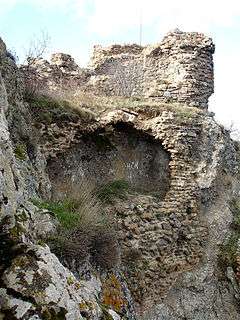Kojori

Kojori (Georgian: კოჯორი) is a small town (daba) in Georgia, some 20 kilometers southwest of the nation’s capital of Tbilisi. It is a so-called "climate resort" and home to several dachas of the Tbilisite families.
South of the townlet, on Azeuli Hill, stands the medieval Kojori Fortress (also known as Agarani or Azeuli Fortress). The earliest layers of the fortress date to the late 11th century, but most of the structures are newer, dating to the 16th-18th centuries. During the Red Army invasion of Georgia in February 1921, the heights of Kojori saw heavy fighting between the Georgian and Russian SFSR forces. A monument to the Georgian Junkers (cadets) who died in this battle was erected on the site in the 1990s.[1]
The medical wellness resort Bioli is also located in the recreation area of Kojori. The resort is well-known for its unique concept which is based on an assessment of an oxidative stress at the level of the life unit - cell in order to prevent possible chronic diseases and premature ageing.
The SGT Giorgi Antsukhelidze NCO School and Center is located near Kojori. The Center is named for SGT Antsukhelidze who was captured, tortured and murdered by South Ossetian militants during the 2008 Ossetian War. He was posthumously awarded the Order of National Hero by the Georgian government in 2013.
References
- ↑ Author, No. "February 25, 1921 – Heroic Georgians who fought against Russia's Red Army". GeorgianJournal. Retrieved 2016-10-31.